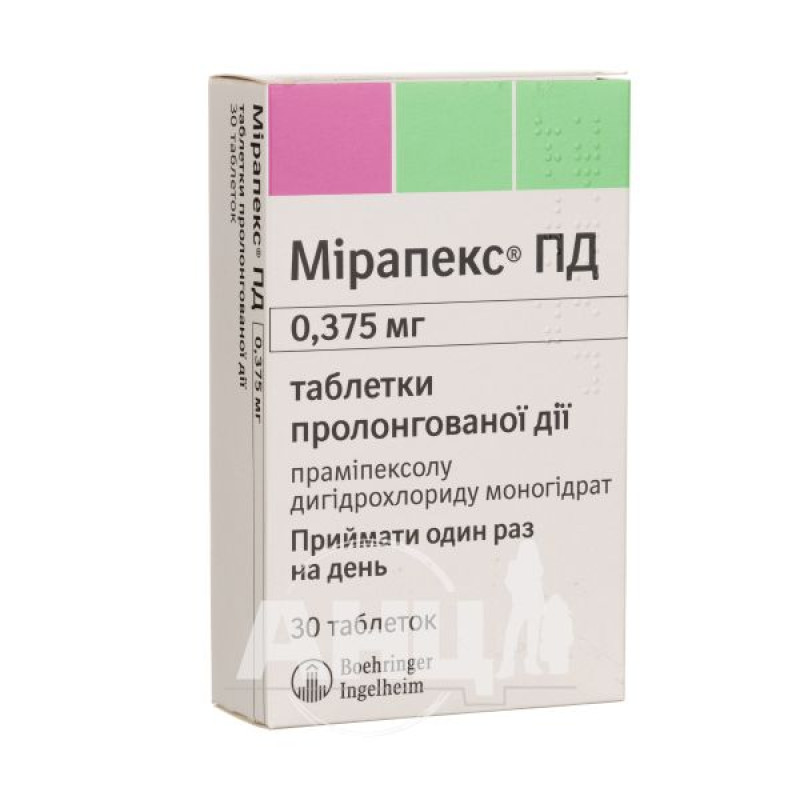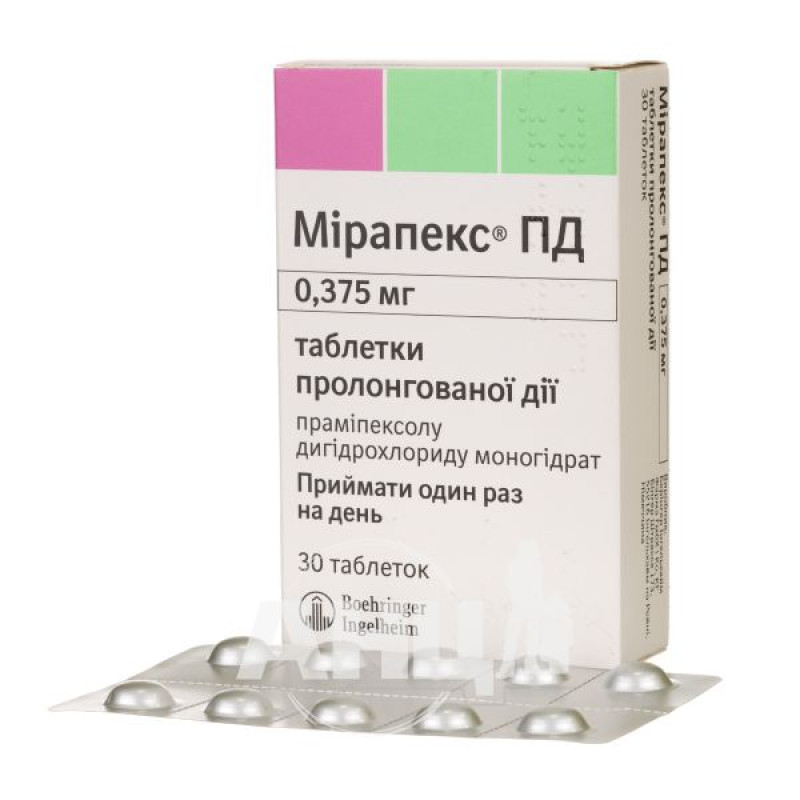Mirapex PD prolonged-release tablets 0.375 mg blister No. 30

MIRAPEX PD tablets are indicated in adults for the treatment of symptoms of idiopathic Parkinson's disease both alone (without levodopa) and in combination with levodopa, i.e. throughout the course of the disease. For the treatment of advanced stages when the effect of levodopa weakens or becomes unstable, and there are fluctuations in the therapeutic effect (dose cessation or fluctuations according to the principle of "works - does not work").
Composition
Active ingredient: pramipexole;
1 extended-release tablet contains:
0.375 mg pramipexole dihydrochloride monohydrate, equivalent to 0.26 mg pramipexole; 0.75 mg pramipexole dihydrochloride monohydrate, equivalent to 0.52 mg pramipexole; 1.5 mg pramipexole dihydrochloride monohydrate, equivalent to 1.05 mg pramipexole;Excipients: hypromellose 2208, corn starch, carbomer 941, colloidal silicon dioxide, magnesium stearate.
Contraindication
Hypersensitivity to pramipexole or any other component of the drug.
Method of application
MIRAPEX PD extended-release tablets are a dosage form of pramipexole intended for once-daily administration.
Doses should be increased gradually, starting at 0.375 mg pramipexole dihydrochloride monohydrate per day, with subsequent increases every 5-7 days. If patients do not experience intolerable side effects, dose titration is necessary to achieve maximum therapeutic effect.
Application features
Pregnant women
The drug can be used during pregnancy only if the expected benefit to the woman outweighs the potential risk to the fetus.
Children
The safety and efficacy of the drug in children (under 18 years of age) have not been established. There is no justification for the use of the drug in children with Parkinson's disease.
Drivers
Pramipexole may have a significant influence on the ability to drive or use machines. Hallucinations or drowsiness may occur.
Patients with drowsiness and/or episodes of sudden onset of drowsiness while taking pramipexole should refrain from driving and from potentially hazardous activities where impaired attention increases the risk of serious injury or death.
Overdose
There is no clinical experience of significant overdose. Adverse reactions expected to occur are those associated with the pharmacodynamic profile of a dopamine agonist, including nausea, vomiting, hyperkinesia, hallucinations, anxiety and hypotension. There is no known antidote for dopamine agonist overdose. If there are signs of central nervous system stimulation, a neuroleptic agent may be indicated. Treatment of overdose may require general supportive measures including gastric lavage, fluid administration, administration of activated charcoal and monitoring of the electrocardiogram.
Side effects
In patients with Parkinson's disease treated with pramipexole, the most common adverse reactions were nausea, dyskinesia, hypotension, dizziness, somnolence, insomnia, constipation, hallucinations, headache and fatigue.
Interaction
The concomitant use of antipsychotic drugs (neuroleptics) with pramipexole should be avoided if antagonistic effects are expected.
Cimetidine reduces the renal clearance of pramipexole by approximately 34%, probably by inhibiting the cationic renal tubular secretion transport system.
Storage conditions
Store in the original packaging in a dry place to protect from moisture, at a temperature not exceeding 25 °C.
Keep out of reach of children!
Shelf life - 3 years.
There are no reviews for this product.
There are no reviews for this product, be the first to leave your review.
No questions about this product, be the first and ask your question.



